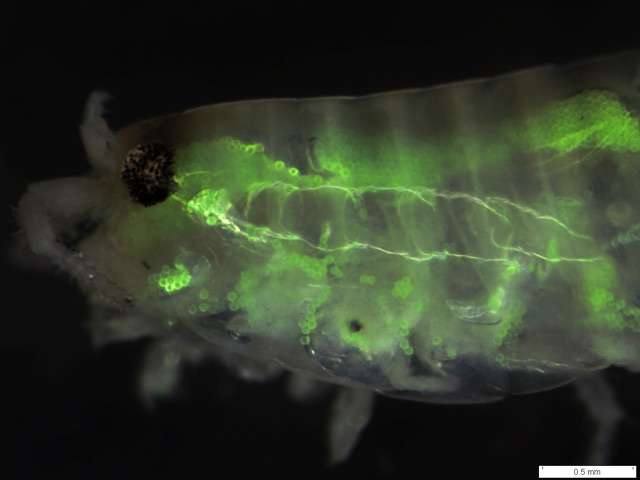Beachhopper survival affected by microplastics

The interaction of large plastic items with marine animals is well known and documented. However, few studies have explored how microplastics – particles of less than 5mm – changes complex behaviours such as predator avoidance and social interactions.
Microplastics are ubiquitous in the marine environment worldwide, and may pose physical and chemical risk to sea life. Their small size makes them bioavailable to a range of organisms and there is evidence that a wide variety of creatures in the marine ecosystem eat them.
Researchers from Macquarie University explored how exposure to microplastics at the same level they may experience in contaminated beaches changes complex behaviours. The results show that consumption of microplastics altered the behaviour of hoppers in ways that ultimately put their lives at risk. The result also serves as a warning sign for wider effects on coastal ecosystems.
"To understand the effects on survival and behaviour, we exposed Plactorchestia smithi (beachhoppers – little jumping animals commonly found in sand) to marine-contaminated microplastics," says Associate Professor Culum Brown.
"Overall, the results show that short-term ingestion can reduce jump height and increase the weight of the beachhoppers, ultimately reducing their capacity to survive and function."
Plastic is a global issue for marine environments due to its conspicuous role in modern lifestyle and economy. Microplastics pose a diverse risk to organisms within marine ecosystems and are introduced to the environment directly or indirectly through breakdown and fragmentation of larger plastic debris.
"In addition to the potential physical effects, chemical effects due to associated contaminants on microplastics now present additional implications for marine biota," says Louise Tosetto.
"Potentially toxic additives such as phthalates, bisphenol A (BPA) and flame-retardants are incorporated into many plastics during manufacturing to increase functionality and extend the life of the plastics."
Beachhoppers are highly mobile organisms that inhabit sediment in wave-washed beaches. They carry out an important ecological role in the function of sandy shores by commencing the decomposition process of sea weed when it is washed up on shore, essential for benthic sediment remineralisation processes. They are also primary consumers and a food source for birds, beetles and fish, therefore important in the transfer of energy between the different trophic levels.
"A reduction in the capacity for beachhoppers to survive and function may have flow-on effects to their local environment and higher trophic levels," says co-author Associate Professor Jane Williamson.
More information: Louise Tosetto et al. Microplastics on beaches: ingestion and behavioural consequences for beachhoppers, Marine Biology (2016). DOI: 10.1007/s00227-016-2973-0
Journal information: Marine Biology
Provided by Macquarie University















